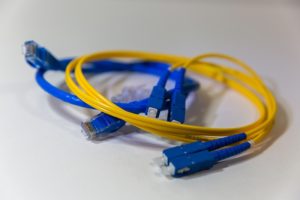When it comes to having a reliable phone system and increasing its uptime, the types of cables used can have a significant impact. Businesses rely on fast internet connectivity to conduct business through the computer and support its VoIP phone service. If the business does not already use a wireless service, then the wired technology should support the business infrastructure to the best of its capabilities. Two common options in the telecommunications industry include copper and fiber optic cabling. Let’s assess the differences in copper cabling and fiber optic cabling’s performance.
Method
Both copper and fiber optic cabling are meant to provide sufficient bandwidth for a business to connect to its internet service. Bandwidth is the maximum data transfer rate, so while it plays a role in a business’s internet connectivity, its actual performance, speed, and reliability is contingent on other factors too. Copper cables transmit electrical pulses to carry data while fiber optic cables transmit light pulses, which are then converted back into electrical signals.
Durability
Copper wires and cables are generally larger than fiber optics. However, copper cannot withstand much tension and tends to break more often than fiber optic cables. While both types of cabling are bundled in a protective jacket, glass fiber optic cables are generally smaller yet more durable. Properly managing cables can reduce the chance of breakages and minimize repair costs.
Range
At long ranges, electric signals traveling through copper wires can weaken. This degradation leads to slow or unsuccessful connectivity. Fiber optic cabling transmits light quickly and reliably, maintaining signal integrity. As a result, fiber cables don’t sacrifice signal quality over greater distances traveled.
Interference
Conducting electricity versus conducting light leaves each cable type vulnerable to various interferences. Power outages or surges, lightning, radio signals, or electromagnetic interference can mess up copper wire transmissions. Conversely, those factors don’t affect light transmissions through fiber optics. Fiber optical transmissions are impacted by the type of fiber used, the light source, and the frequency of the transmissions. Adequately assessing a business’s needs allows your service providers to install single-mode or multi-mode fiber cables to avoid transmission issues.
Phone System Solutions from Delta Intellicom
Want to learn more about the ways we can help improve your business? Delta Intellicom can satisfy all of your telecommunication needs, whether you need help with your new VoIP system or just want to streamline your existing office phone network. We have served the Maryland, Washington, D.C, Northern Virginia, and Pennsylvania areas for over 20 years and offer an unparalleled customer experience. We have the expertise and products to fulfill all of your phone service and data needs. For more information, contact us online or give us a call at 1-800-946-3358. For more tips, follow us on Facebook, Twitter, and Pinterest.


2 Comments